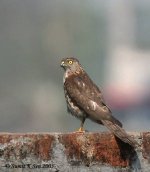Hi Folks!
At the outset let me mention that this could be a tough one. This one has done the rounds in many forums and no positive ID has emerged till date. Also, some members may not be familiar with far-eastern species.
I think it is fair to add some details:
1. Shot in Kolkata (Calcutta), India last November
2. Bird in the 30-35 cm range (not very useful!)
3. Seen near paddy-fields, most obvious prey seemed to be amphibians and reptiles.
4. Kolkata is in eastern India and the known/possible accipiters in the area are:
Shikra (a. badius)- most common accipiter
Eurasian Sparrowhawk (a. nisus) - no known records
Besra (a. virgatus) - no known records
2 others considered possible are:
Chinese Sparrowhawk (a. soloensis)
Japanese Sparrowhawk (a. gularis)
I have witnessed some wonderful work on this forum. So I thought it well worth submitting this bird to the members.
I can add the short-list, but that may add bias. Maybe, later, if the thread develops!
Sumit
At the outset let me mention that this could be a tough one. This one has done the rounds in many forums and no positive ID has emerged till date. Also, some members may not be familiar with far-eastern species.
I think it is fair to add some details:
1. Shot in Kolkata (Calcutta), India last November
2. Bird in the 30-35 cm range (not very useful!)
3. Seen near paddy-fields, most obvious prey seemed to be amphibians and reptiles.
4. Kolkata is in eastern India and the known/possible accipiters in the area are:
Shikra (a. badius)- most common accipiter
Eurasian Sparrowhawk (a. nisus) - no known records
Besra (a. virgatus) - no known records
2 others considered possible are:
Chinese Sparrowhawk (a. soloensis)
Japanese Sparrowhawk (a. gularis)
I have witnessed some wonderful work on this forum. So I thought it well worth submitting this bird to the members.
I can add the short-list, but that may add bias. Maybe, later, if the thread develops!
Sumit




